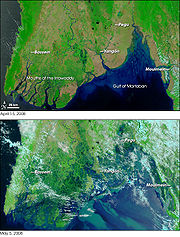
Back إعصار نرجس Arabic ঘূর্ণিঝড় নার্গিস Bengali/Bangla Cicló Nargis Catalan Cyklón Nargis Czech Cyklonen Nargis Danish Zyklon Nargis German Κυκλώνας Ναργκίς Greek Cyclone Nargis English Ciklono Nargis Esperanto Ciclón Nargis Spanish


Cyclone Nargis was a tropical cyclone. It was the first in the Indian Ocean in 2008. It was a Category 4 storm. It made landfall (went on land) in Myanmar (Burma) in April and May 2008. It was possibly one of the worst storms to have hit the country.
The United Nations estimated in its report that 1.5 million people were severely affected by this cyclone.[1] Officially at least 78,000 were killed with 58,000 missing.[2][3] After the disaster, the Burmese government called for help in dealing with the situation.[4] Some people said the government had problems coping with the situation.[5]
More recent reports from the government say that about 80,000 have died. Some non-governmental organizations estimate that the final number will be well over 100,000.[6] Aid workers that came into the country estimate that 2 to 3 million are homeless, in the worst disaster in Burma’s history. They say it is comparable with the 2004 Indian Ocean tsunami. Andrew Kirkwood, country director of a British charity organisation said: "We're looking at 50,000 dead and millions of homeless. I'd characterise it as unprecedented in the history of Burma. [It has had about the same effect as] the tsunami on individual countries. There might well be more dead than the tsunami caused in Sri Lanka."[7] The United Nations said that up to 2.5 million people needed help urgently.[8] The Red Cross said there could be up to 128,000 dead.[8]
The storm caused the government to declare five regions as disaster areas. - Yangon, Ayeyarwady, Bago Divisions, Mon and Kayin States. Thousands of buildings were destroyed; in the town of Labutta, located in the Ayeyarwady Division, state television reported that 75% of buildings had collapsed, and 20% had their roofs ripped off.[9] It is believed that the cyclone is the deadliest tropical cyclone in the world since Hurricane Mitch in 1998, which killed about 18,000 people. At least 10,000 people have been reported to have died in the delta town of Bogale.[10]
A diplomat in the city of Yangon spoke to the Reuters news agency. He said that the area around him looked like a 'war zone' as a result of the cyclone. Burst sewage mains caused the landscape to flood with waste, ruining the rice crop.[11] An official from the United Nations also talked about the situation, at the time of the event. "It's a bad situation. Almost all the houses are smashed. People are in a terrible situation," he said. Another UN representative reported that "The Irrawaddy delta was hit extremely hard not only because of the wind and rain but because of the storm surge." The Daily Telegraph, a UK newspaper, reported that food prices in Myanmar could be affected by this disaster.[12][13]
- ↑ "UN: 1.5 million people affected by Myanmar storm". Abs-Cbn Interactive.
- ↑ "Burma death toll jumps to 78,000". BBC News. 16 May 2008. Retrieved 17 May 2008.
- ↑ "Burma's cyclone death toll soars". BBC News Online. 8 May 2008. Retrieved 8 June 2008.
- ↑ "Aid call as Burma casualties rise". BBC News.
- ↑ "Disaster tests Burma's junta". BBC News Online.
- ↑ "Myanmar deaths may top 100,000: U.S. diplomat". Yahoo.[permanent dead link]
- ↑ "Burma cyclone: up to 50,000 dead and millions homeless, but still no call for aid". British Times online. Archived from the original on 2008-05-12. Retrieved 2008-05-07.
- ↑ 8.0 8.1 "'No access' to Burma cyclone zone". BBC News Online. 14 May 2008.
- ↑ "Hundreds killed by Burma cyclone", BBC News, 4 May 2008.
- ↑ "Cyclone kills 10,000 in one Myanmar Town - Reuters, 6 May 2008"
- ↑ "UPDATE 1-Myanmar cyclone stirs more rice supply fears". Archived from the original on 2008-05-06. Retrieved 2008-05-06.
- ↑ "351 die as Cyclone Nargis hits Myanmar". MSNBC.
- ↑ "Burma cyclone kills more than 350 people". Telegraph.